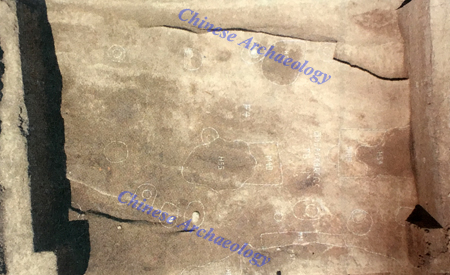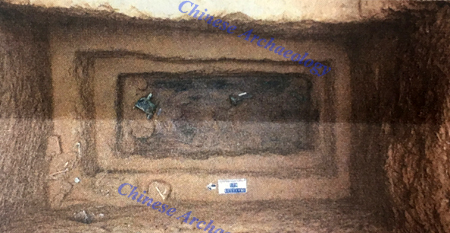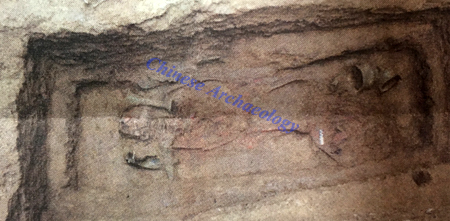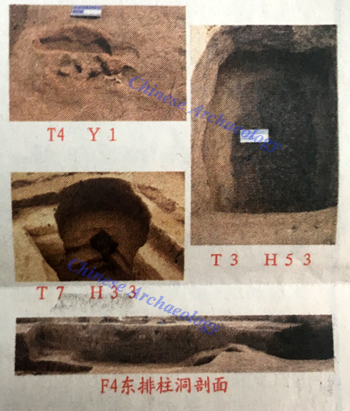Late Shang settlement and bronze-casting workshop found at Xindian, Henan Province
From:Chinese Archaeology NetWriter:Date:2017-10-10
From May to July 2016, Anyang Municipal Institute of Archaeology conducted the excavation at the Late Shang settlement and bronze-casting workshop remains near the Xindian village, Anyang City in Henan Province. A number of house remains, roads, ash pits, storage pit, kilns for porcelain moulds, bronze-casting workshop remain and several tombs from the late Shang Dynasty were uncovered. Along with these remains, there were also clay moulds and tools for bronze casting, bronze ritual vessels, weapons, lacquer wares, jade wares and potteries and so on.
Aerial photo demonstrated T4:F6 and its related remains

An illustration of Tomb M21 shows the layout of the grave when it was excavated.
Remains of Shang Dynasty
Houses Remains: there were 5 house remains found in total. Taking House Remain F4 for example,it illustrates the typical style of the structure in the settlement. It was 15 m long from north to south. 3 rows of postholes were aligned along the west-east direction. In each row, postholes were dug along the north-south direction. These postholes were filled with pebbles and several of them were even rammed.
Ash Pits, Storage Pits and Wells: these types of features added up to 63. 800 pieces of clay moulds fragments were excavated, among which pit H4, H8, H25, and well H13 and H4 yielded quite a large number of it. For example, in pit H4 over 20 clay moulds were found, several of which were decorated with beautiful patterns. One clay mould was preserved in so good condition that even the mortise and tenon joint structure could be clearly identified. As its inner surface was imprinted with ribbon pattern, nipple-nail and cloud pattern, this mould might have been used for casting ding tripod vessel.
Casting-related remains
Intaglio mould (Yinfan) pit is a type of pit that storing the intaglio mould. Pit H53 was a rectangular shaft pit with straight walls which were carefully processed. Near the opening of the pit, several concave holes were cut into the wall. The bottom of the pit was flat, where walls partially fell down. A layer of 0.90 m deep charcoal was buried over the bottom. From this pit, there were discoveries of tools for making clay moulds along with clay moulds and furnace walls.
Pit H33 comprising the kiln for firing clay moulds. The pit had a bottom which was bigger that its opening and its walls were well processed. Both the walls and bottom were fired, leaving traces of 2-5 mm deep burned earth layers which appeared in orange colour. In the middle of the pit bottom, there was a small rectangular pit within which charcoal were deposited.

An illustration of Tomb M41 shows the layout of the grave when it was excavated.
Tombs
Over 40 tombs were dated to the late Shang Dynasty, 5 of which yielded bronze vessels. Tomb M21 and M41 were small-medium sized tombs for Shang elites, in which a number of lacquer ware were buried along with bronze ritual vessels.
Tomb M21 was a rectangular earthen shaft pit tomb, of which the bottom was larger than the opening. The tomb opening was 2.8 m long and 1.40 m wide. The filling soil in the tomb was mixed with pottery fragments, animal bones and charcoal. A semi-circle shaped niche was located in the west wall of the tomb chamber which was 1.20 m high from the bottom. The niche had a flat bottom. A rammed secondary platform was found around the bottom of the tomb. A waist pit was located in the center (slightly eastwards) of the tomb. One inner coffin and one outer coffin were placed in the chamber. Neither of them was preserved but still there were traces demonstrating its ‘井’shape. The skeleton was seriously rotten. Seen from the remaining part, it was in prone position, whose head was deposited towards the north. The skeleton seemed an adult whose gender cannot be determined.
Tomb M21 was buried with rich grave goods including bronze vessels, potteries, jades, lacquer ware, bone tools and stone tools, adding up to over 30 pieces let alone shell tools. There were 4 bronze ritual vessels; they are ding tripod, gu goblet, kettle and jue vessel. 9 bronze weapons were found (4 swords, 4 spears, 1 dagger cap). Another 6 pieces of bronze tools include 3 axes, 1 spade, 1 chisel, 1 knife. 2 bronze bells were collected. Apart from bronze wares, there were 1 pottery li vessel, 5 jade items (3 tubes, 1 huang pendent, 1 hair pin), 1 bone tool, and 4 to 5 lacquer dou and lei vessels.
Tomb M41 was a rectangular earthen shaft pit tomb with secondary platform around the bottom. In the center of the tomb laid a waist pit. The inner and outer coffins in the chamber had been decayed. The human skeleton was a male adult. 21 grave goods were found in this tomb. There was 4 bronze ritual vessels (1 ding tripod, 1 gui vessel, 1 gu goblet, 1 jue vessel); 8 bronze weapons (including 6 swords and 2 spears); 3 bronze tools (2 axes, 1 spade); 2 musical instruments (bronze bells); 3 jades (1 tube, 1 accessory, 1 ring); 1 bone knife, 1 shell and 3 lacquer ware.

Different kinds of remains
This site of the late Shang Dynasty located at Xindian was the first discovery of large scale Shang settlement in the north Anyang area, which provides rich information about the overall layout of the Yinxu (Ruins of Yin). The bronze-casting workshop was coeval with Yinxu. Demonstrated by those clay moulds for bronze casting, the Xindian site might have been another workshop for casting bronze ritual vessels, in addition to the discovery at the Yinxu (Ruins of Yin).
The bronze-casting workshop that located outside Yinxu (Ruins of Yin) suggests that bronze had become an important part which had influences upon residents near the late Shang capital. Besides, it also illustrates that groups of craftsmen expertizing bronze casting and trading had formed as the casting technology developed through time. Without doubt, these craftsmen groups must have had profound influences upon the expanding of the Shang and the exchange between the Shang and other culture. (Translator: Dong Ningning)

